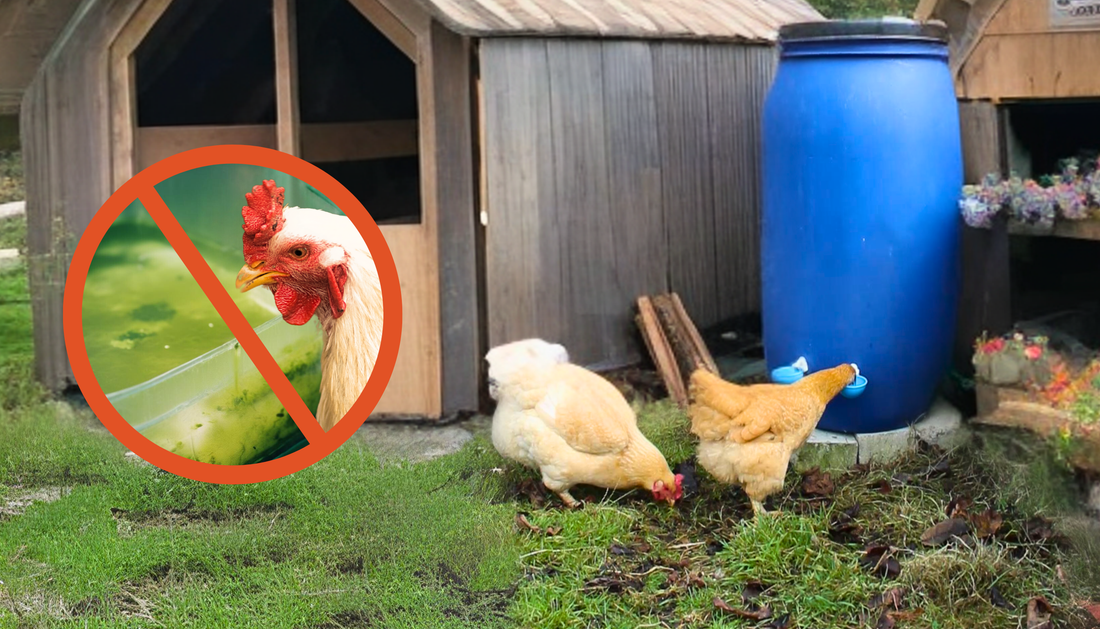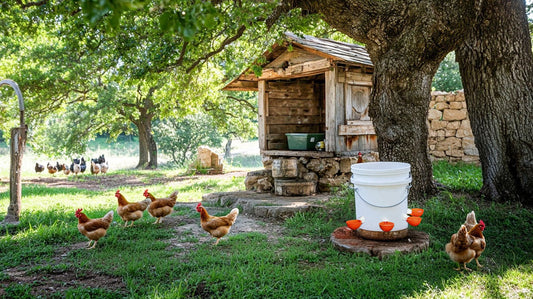How to Keep Your Poultry's Water Algae-Free
Imagine this: it's a bright morning on your farm, and as you walk to your chicken coop, you’re greeted by the cheerful clucks of your hens. You reach for their water container to give it a quick top-up, only to find it coated in a slimy, green film.
For many poultry keepers, algae is a relentless foe, turning once pristine water sources into swampy, unappealing messes. This isn't just an eyesore; it can affect your chickens' water intake and, ultimately, their health. But fear not! In this blog, we’re diving deep into the world of algae prevention. So get ready to reclaim your waterers and ensure your poultry stays happy and hydrated!
Understanding the Enemy, What is Algae?
Algae are simple, photosynthetic organisms that thrive in water. They need sunlight, water, and nutrients (like those found in your chickens' droppings) to grow. When these conditions are met, algae can proliferate rapidly, turning your water containers into green slime factories. This not only looks unappealing but can also affect the taste of the water, potentially leading to reduced water intake and health issues for your birds.
Here are some strategies to keep those water containers algae-free and your poultry hydrated and happy.

1. Location, Location, Location!
First things first, where you place your water containers can make a big difference. Algae love sunlight as much as we love our morning coffee. So, finding a shady spot to place your waterers can significantly reduce growth. No need to build a waterer cabana (though that would be adorable), Consider the natural shade provided by trees, buildings, or even the chicken coop itself. If natural shade is scarce, you can create artificial shade using tarps or shade cloth.
2. Keep It Clean
Regular cleaning is key. Make it a part of your routine to scrub those waterers with a good brush at least once a week, or more often during hot weather when algae growth can accelerate. You don’t need to channel your inner Cinderella, but a little elbow grease goes a long way. Rinsing with a vinegar solution (1 part vinegar to 10 parts water) can help to sanitize the containers and deter algae growth too—algae hates vinegar almost as much as your kids hate doing chores.
3. Block the Sun
If you’re battling relentless sunshine, consider investing in opaque water containers. Clear or translucent containers allow sunlight to penetrate, promoting algae growth. Hence, the less light that gets in, the less algae can grow. Opaque containers like the one above, on the other hand, block sunlight, making it much harder for algae to thrive. If you already have clear containers, you can paint them with non-toxic paint or wrap them in a light-blocking material.
Think of it as providing your water with a pair of sunglasses—cool and effective.
4. Get Moving
Stagnant water is a perfect breeding ground for algae. Keeping the water in motion can disrupt algae growth. Installing a small, solar-powered water pump or aerator that can create a little circulation, which makes it harder for algae to set up shop. This not only helps prevent algae but also ensures that the water remains oxygenated and fresh for your poultry. Plus, your chickens might enjoy the gentle babbling brook effect.
5. Add Some Allies
There are natural additives you can use to discourage algae. Adding a small amount of apple cider vinegar to your chickens' water can lower the pH slightly, creating an environment that is less favorable for algae. Aim for about one tablespoon of apple cider vinegar per gallon of water. However, do not use in metal containers as it can react with the metal and be careful not to overdo it, as too much acidity can harm your birds.
6. Use the Power of Science
Hydrogen peroxide is another safe option for preventing algae growth. A small amount of food-grade hydrogen peroxide (3% concentration) can be added to the water to prevent algae without harming your poultry. A typical dilution rate is one teaspoon of hydrogen peroxide per gallon of water. This solution helps keep the water clean and free from algae so just make sure to follow the correct dilution instructions—no one wants foamy chicken beaks!
7. Upgrade Your Gear
Consider automatic waterers with nipples as they can be highly effective in reducing algae growth. These systems limit the amount of water exposed to air, reducing the chances of algae taking hold. Nipple waterers dispense water directly into the bird's mouth, keeping the bulk of the water enclosed and protected from sunlight and contaminants. They're also less likely to become contaminated with dirt and debris.
Plus, watching your chickens use them is oddly satisfying, like seeing someone master a tricky game of Jenga.
8. Embrace the Weird and Wonderful
Finally, if all else fails, get creative. Some farm keepers swear by floating a small piece of copper in the water, as copper is a natural algicide. Copper ions can inhibit the growth of algae and other microorganisms. Ensure that the copper piece is poultry-safe, with no sharp edges or toxic coatings. It's also important to monitor your birds to ensure they are not adversely affected by the copper.
Bonus Tips: Consistency is Key
Consistency in your maintenance routine is critical to preventing algae growth. Regularly checking and cleaning your water containers, maintaining proper shade, and using appropriate additives can keep algae at bay.
Also, don’t forget to keep a farm journal to track your maintenance schedule and any issues can help you stay on top of things and make adjustments as needed.
By understanding the conditions that promote algae growth and implementing these strategies, you can keep your poultry's water clean and algae-free. This not only ensures that your birds have access to fresh, healthy water but also saves you time and effort in the long run. Here's to happy, hydrated hens and an algae-free water supply!





